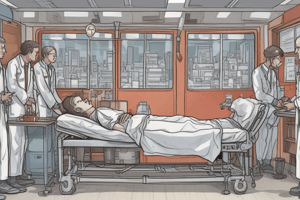Podcast
Questions and Answers
Apa yang termasuk dalam kategori ESI A?
Apa yang termasuk dalam kategori ESI A?
- Pasien yang mengalami nyeri ringan
- Pasien dengan kebingungan mental yang baru muncul
- Pasien dengan vital sign dalam batas normal
- Pasien yang memerlukan dukungan pernapasan (correct)
Kondisi mana yang memerlukan penilaian ulang untuk menentukan tingkat keparahan pasien?
Kondisi mana yang memerlukan penilaian ulang untuk menentukan tingkat keparahan pasien?
- Pasien yang mengalami nyeri parah
- Pasien dengan demam tinggi tanpa sumber yang jelas
- Pasien yang tampak stabil secara klinis
- Pasien dengan satu atau lebih vital sign di luar parameter normal (correct)
Jumlah sumber daya dalam ESI dihitung berdasarkan?
Jumlah sumber daya dalam ESI dihitung berdasarkan?
- Jumlah jenis sumber daya yang berbeda (correct)
- Frekuensi pemeriksaan vital sign
- Jumlah keseluruhan tes laboratorium yang dilakukan
- Total waktu tunggu sampai pengobatan
Berapa lama waktu tunggu maksimum yang diperbolehkan untuk kategori ATS 4?
Berapa lama waktu tunggu maksimum yang diperbolehkan untuk kategori ATS 4?
Apa yang seharusnya dipertimbangkan untuk anak usia 1-3 bulan dengan demam?
Apa yang seharusnya dipertimbangkan untuk anak usia 1-3 bulan dengan demam?
Flashcards
Kategorisasi ATS (Advanced Trauma System)
Kategorisasi ATS (Advanced Trauma System)
Kategori ATS didefinisikan oleh prediktor fisiologis (jalan napas, pernapasan, sirkulasi, dan disabilitas) dan waktu tunggu maksimum untuk perawatan. Prioritas 1: segera, 2: 10 menit, 3: 30 menit, 4: 60 menit, 5: 120 menit.
ESI (Emergency Severity Index)
ESI (Emergency Severity Index)
Sistem klasifikasi pasien berdasarkan tingkat keparahan kondisi yang membutuhkan intervensi cepat. Terdiri dari kategori prioritas, pasien diprioritaskan berdasarkan kebutuhan intervensi langsung untuk menyelamatkan nyawa atau resiko cepat memburuk kondisi.
Kriteria ESI kategori 'Immediate life-saving intervention'
Kriteria ESI kategori 'Immediate life-saving intervention'
Pasien dengan kebutuhan intervensi gawat darurat untuk menyelamatkan nyawa, seperti dukungan jalan napas atau pernapasan, obat-obatan darurat, intervensi hemodinamik, resusitasi cairan atau produk darah. Contohnya: pasien yang terintubasi, tidak responsif, tanpa denyut nadi, apnea, sesak napas berat, hipotensi atau hipoglikemia berat.
Kriteria ESI kategori 'High-risk situation'
Kriteria ESI kategori 'High-risk situation'
Signup and view all the flashcards
Pertimbangan Demam Bayi
Pertimbangan Demam Bayi
Signup and view all the flashcards
Study Notes
Triage & Musculoskeletal Emergencies
- Triage is a process to determine the priority of patient treatments based on the severity of their condition.
- It efficiently rations patient treatment when resources are insufficient for immediate treatment of all.
- The term "triage" comes from the French verb "trier," meaning to separate, sort, sift, or select.
Purpose & Benefits of Triage
- Expedite time-critical treatment for life-threatening conditions.
- Ensure appropriate categorization of patients requiring emergency care based on their clinical condition.
- Improve patient flow.
- Improve patient satisfaction.
- Decrease overall length of stay.
- Facilitate streaming of less urgent patients.
- Be user-friendly for all levels of healthcare professionals.
Currently Utilized Triage Systems
- CTAS (Canadian Triage and Acuity Scale)
- ESI (Emergency Severity Index)
- ATI (Australian Triage Index)
CTAS National Guidelines
- CTAS Level 1: Patients need immediate physician assessment (98% of the time).
- CTAS Level 2: Patients need physician assessment within 15 minutes (95% of the time).
- CTAS Level 3: Patients need physician assessment within 30 minutes (90% of the time).
- CTAS Level 4: Patients need physician assessment within 60 minutes (85% of the time).
- CTAS Level 5: Patients need physician assessment within 120 minutes (80% of the time).
ESI Emergency Severity Index
- Level 1: Requires immediate life-saving intervention.
- Level 2: High-risk situation (confused, lethargic, disoriented, severe pain, or distress).
- Level 3: Multiple resources required (consider upgrading to level 2 if specific vital sign criteria are met).
- Level 4: One resource required.
- Level 5: No resources needed.
ATI/ATS
- ATS categories are defined by physiological predictors (airway, breathing, circulation, disability) and maximum waiting time to treatment.
- 1: Immediate
- 2: 10 minutes
- 3: 30 minutes
- 4: 60 minutes
- 5: 120 minutes
ESI - Conceptual Algorithm
- Algorithm outlining decision steps based on specific patient scenarios. Check for immediate life-saving intervention need, high-risk situations, and resource needs.
ESI Resources
- Resources like labs, imaging, and procedures are counted as part of the need assessment.
Not ESI Resources
- Items that are not counted towards resource needs. Includes things like history and physical exams, certain lab tests, medications, etc.
High-risk Vital Signs (ESI)
- Reassessment is needed to determine whether a higher acuity level needs to be assigned if a patient has one or more vital signs outside the normal parameters.
Pediatric Fever Considerations (ESI)
- Younger infants and children may warrant higher ESI levels for fever conditions. Specific age ranges and temperature criteria are outlined for appropriate ESI assignment.
ESI Triage Levels (Table)
- A table of vital sign parameters for Red, Orange, Yellow, and Green triage levels.
Studying That Suits You
Use AI to generate personalized quizzes and flashcards to suit your learning preferences.




